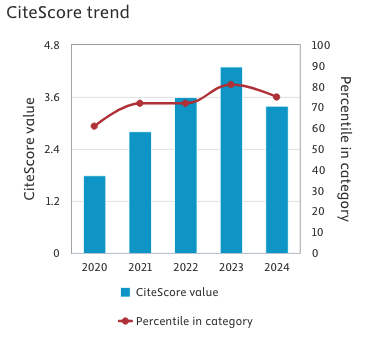The Nursing Management of Tourniquet: the infective risk related to its use
Tourniquet management and contamination risk
Keywords:
Tourniquet, venepuncture, contamination risk, care-related infections, infection prevention, decontamination techniques, hand hygieneAbstract
Background and aim of the work: Reusable tourniquets should be considered and used in clinical practice as semi-critical devices, as they are colonized by potentially pathogenic agents, a possible cause of care-related infections. The aim of the study was to analyse the management of tourniquets in the clinical reality of wards, investigating the aspects related to their use in venepuncture procedures, the cleaning process after their use and storage.
Methods: It has been conducted an observational study with a questionnaire on a sample of nurses (N = 73) and nursing students (N = 60) recruited in a hospital and in an University of northern Italy.
Results: Data revealed a very positive attitude regarding the high standards of hand hygiene among nurses and nursing students sampled; the critical issues concern the lack of shared protocols or guidelines for the management of tourniquets that lead to discussion both on their use in clinical practice and on the disinfection process after use as well as tourniquets disposal.
Conclusions: Tourniquets can represent a serious potential danger in terms of infections transmission, especially in the pandemic period we are experiencing; their use is practically transversal in all healthcare settings and it is therefore necessary to implement the use of shared management and disposal guidelines / protocols. From this research it appears that in the setting explored, although much attention is paid to hand hygiene, this aspect still seems to be a critical point of nursing care.
References
Golder M, Chan CL, O’Shea S, Corbett K, Chrystie IL & French G. Potential risk of cross-infection during peripheral-venous access by contamination of tourniquets. Lancet, 2000; 355(9197), 44.
Yokoe DS, Anderson DJ, Berenholtz SM, et.al. A compendium of strategies to prevent healthcare-associated infections in acute care hospitals: 2014 updates. Infection Control & Hospital Epidemiology, 35(S2), S21-S31.
Gorski L, Hadaway L, Hagle ME, Doellman D, McGoldrick M & Orr M. Standards of Practice Infusion Therapy. Chemical Physics Letters, 2016; 39(1S).
World Health Organization.. WHO guidelines on drawing blood: best practices in phlebotomy. 2010, World Health Organization.
Costa P. Gestão de material clínico de bolso por enfermeiros: fatores determinantes e avaliação microbiológica, 2017; 1–174.
Ahmed SM, Ahmad R, Case R. & Spencer RF. A study of microbial colonisation of orthopaedic tourniquets. Annals of the Royal College of Surgeons of England, 2009; 91(2), 131–134.
Pinto AN, Phan T, Sala G, Cheong EY, Siarakas S. & Gottlieb T. Reusable venesection tourniquets: A potential source of hospital transmission of multiresistant organisms. Medical Journal of Australia, 2011; 195(5), 276–279.
Culjak M, Gveric Grginic A & Simundic AM. Bacterial contamination of reusable venipuncture tourniquets in tertiary-care hospital. Clinical Chemistry and Laboratory Medicine, 2018; 56(8), e201–e203.
Brennan SA, Walls RJ, Smyth E, Mulla TA & O’Byrne JM. Tourniquets and exsanguinators: A potential source of infection in the orthopedic operating theater? Acta Orthopaedica, 2009; 80(2), 251–255.
Schauer CK & Hammer DA. Quantifying patient bacterial exposure risk from reusable phlebotomy tourniquets in a New Zealand secondary level hospital. Journal of Infection Prevention, 2015; 16(6), 262–265.
Kalyani CS, Koripella R & Valli SN. Isolation of Potentially Pathogenic Bacteria from Reusable Venesection Tourniquets in a Tertiary Care Hospital. International Journal of Current Microbiology and Applied Sciences, 2016; 5(5), 153–157.
Grohmann M, Schomakers L, Wolschendorf F, Grosch J, Lindner S. & Witte AK. Reduced bacterial contamination rates detected on silicone tourniquets compared to conventional tourniquets in clinical routine. BMC Infectious Diseases, 2020; (1), 1–6.
Thompson SM, Middleton M, Farook M, Cameron-Smith A, Bone S & Hassan A. The effect of sterile versus non-sterile tourniquets on microbiological colonisation in lower limb surgery. Annals of the Royal College of Surgeons of England, 2011; 93(8), 589–590.
Sahu SK, Tudu B & Mall PK. Microbial colonisation of orthopaedic tourniquets: A potential risk for surgical site infection. Indian Journal of Medical Microbiology, 2015; 33(5), 115–118.
Mufarrih SH, Qureshi NQ, Rashid RH, Ahmed B, Irfan S, Zubairi AJ & Noordin S. Microbial Colonization of Pneumatic Tourniquets in the Orthopedic Operating Room. Cureus, 2019; 11(8), 8–14.
Rosner B. Fundamentals of biostatistics. 2015, Cengage learning.
Downloads
Published
Issue
Section
License
Copyright (c) 2021 Georgiana Paduret, Flavia Primosa, Mary Jean Bujdos, Giovanna Artioli, Leopoldo Sarli, Rachele La Sala, Rita Bruna Dicembrino, Sandrino Luigi Marra, Giuseppe Marletta

This work is licensed under a Creative Commons Attribution-NonCommercial 4.0 International License.
This is an Open Access article distributed under the terms of the Creative Commons Attribution License (https://creativecommons.org/licenses/by-nc/4.0) which permits unrestricted use, distribution, and reproduction in any medium, provided the original work is properly cited.
Transfer of Copyright and Permission to Reproduce Parts of Published Papers.
Authors retain the copyright for their published work. No formal permission will be required to reproduce parts (tables or illustrations) of published papers, provided the source is quoted appropriately and reproduction has no commercial intent. Reproductions with commercial intent will require written permission and payment of royalties.






